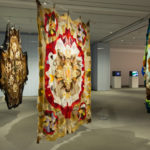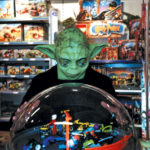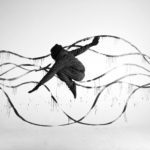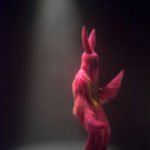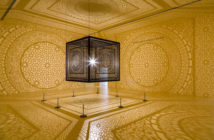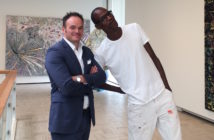Included in the exhibition Playtime at the Peabody Essex Museum is a piece by Cory Arcangel where he manipulates the classic old-school Nintendo game Super Mario Bros. A TV monitor shows Mario stranded on a block surrounded by blue sky. If Mario moves, he falls to his death. Arcangel has hacked the game to render it unplayable, and the title Totally Fucked says it all. Walking through Playtime during a raucous preview party full of teenagers, many in anime-inspired cosplay outfits, I thought about how art purists bemoan the fact that the museum has become a playground for selfies and social events. Struggling to reach young audiences, many museums may feel a little bit like Mario on the block: one move in any direction and you’re fucked. Traditional formats and approaches may be dead on arrival, and spectacles intended to be easily consumable via iPhone can be vacuous pandering.
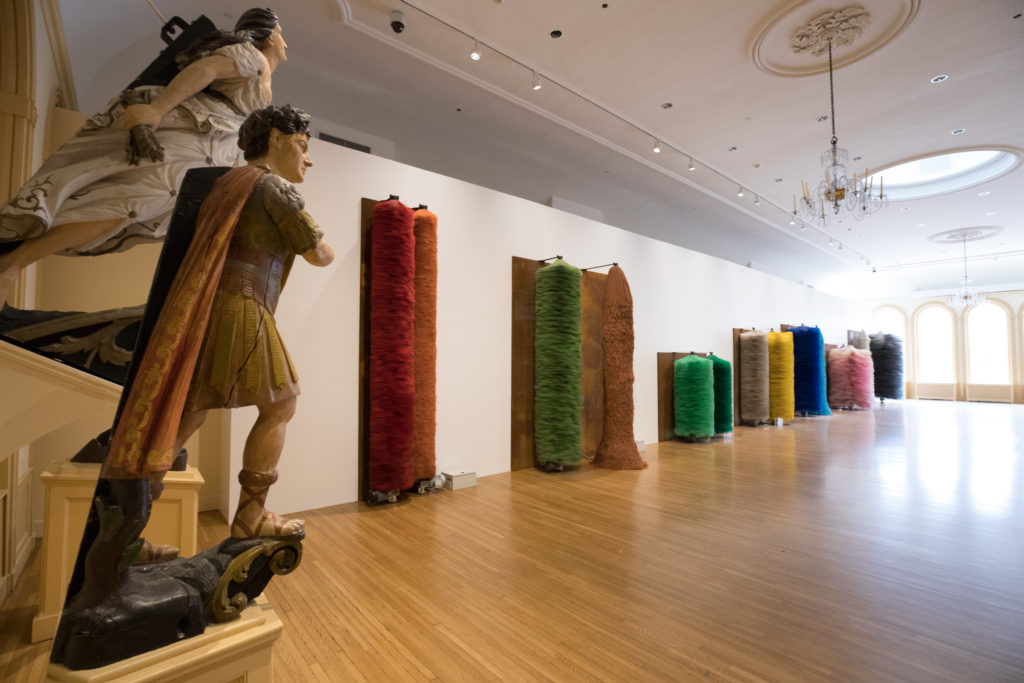
Lara Favaretto, Coppie Semplici / Simple Couples, 2009
Courtesy Peabody Essex Museum
Fortunately, Playtime manages to walk a fine line that gets serious about play and plays with the self-seriousness of the museum. The most dramatic example of this is in the Grand Maritime Hall, the original room of the museum, where Lara Favaretto’s installation of spinning car wash brushes disrupt the otherwise staid setting. On the surface, it could fall flat as a gimmicky act of dislocation and juxtaposition, but the industrial car wash rollers take on a strange new life as whirling dervish diptychs in color combinations that bring to mind monolithic abstractions. Approaching them, many surprisingly large and overpowering, you can feel the force of their whipping bristles and the wind on your skin. Named after real human couples, each pairing of brushes either wears the other down or moves obliviously at oscillating velocities – a darker metaphor for human relationships. This is not just a playful gesture, but a forceful one.
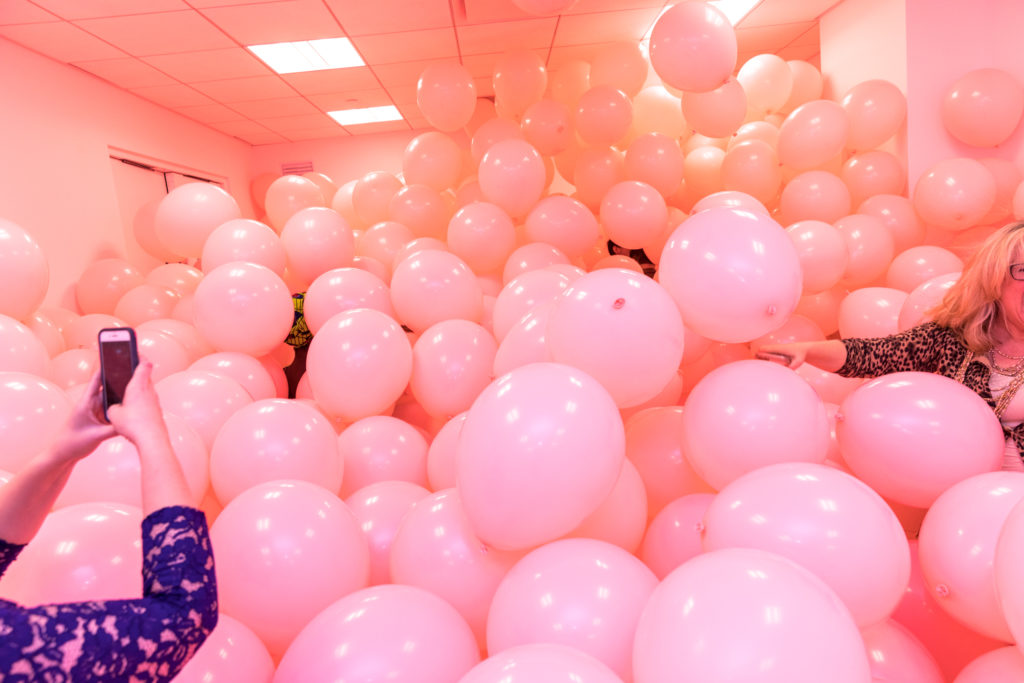
Martin Creed, Work No. 329 (detail), 2004
Courtesy Peabody Essex Museum
Much of the work in Playtime has an interactive and sensory component. The exhibition begins with one of Martin Creed’s installations where visitors can wade through a room full of pink balloons. At first tranquil, the experience becomes fun and chaotic. Balloons set my hair on end with static electricity and submerged me as I tried to exit without letting any pop. Erwin Wurm’s wonderful series of One Minute Sculptures direct participants to step up onto low pedestals and contort themselves into humorous poses with banal objects – like instructing two people to wear one sweater or to balance household products between their bodies. Wurm also stretches a pink sweater to architectural proportions transforming the neckhole into a viewing portal. Pedro Reyes’ musical instruments made entirely from weapons confiscated by the Mexican government can be heard throughout the show producing surprisingly beautiful sounds from a gun barrel ensemble. These artists do not just play with their materials, but with a visitor’s expectations, body, and full range of senses.
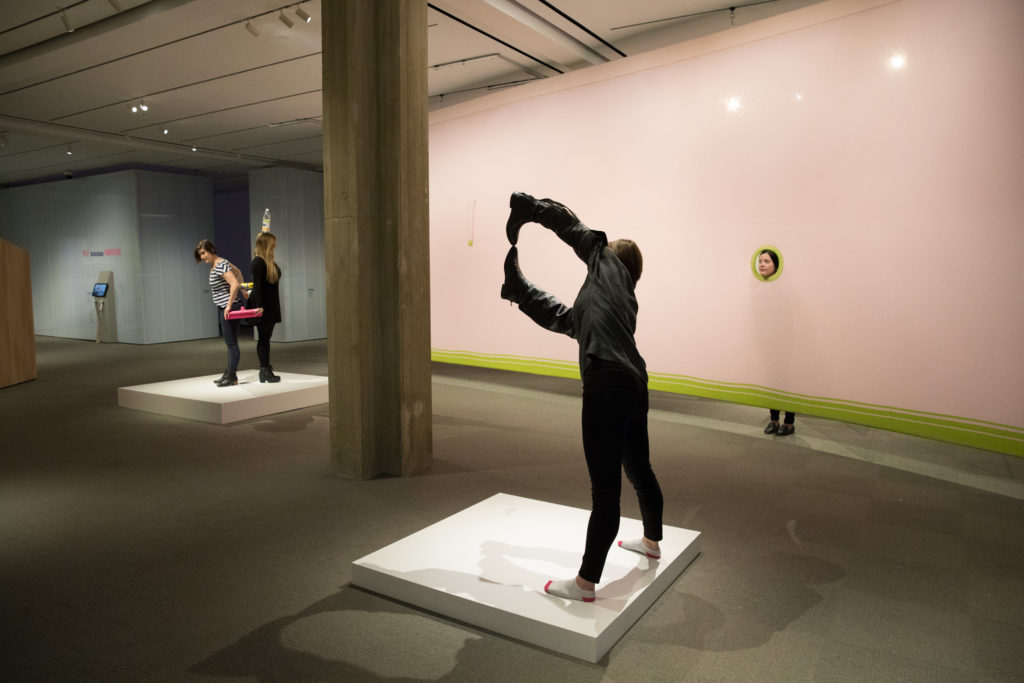
Erwin Wurm, One Minute Sculptures series, 1997–present (foreground)
Sweater, pink, 2018 (background)
Courtesy Peabody Essex Museum
Individual works of painting and drawing are absent. The photography, sculpture, and video that are included that take a more traditional approach of presenting works for detached contemplation vie for attention next to their interactive counterparts. Mark Bradford’s iconic video of himself struggling to play basketball in a large antebellum hoop skirt is layered with meaning about racial and sexual identity but feels lost in the shuffle near Wurm’s participatory pieces and a table with iPad kiosks. A Paul McCarthy video, the darkest work in the show and only piece with a warning label, is given a more traditional video space, and it features a Pinocchio character flinging ketchup in sexually suggestive ways. While I watched the grotesque video, one visitor struggled to see the playfulness as they immediately blurted out, “Oh my god that is terrifying,” and quickly exited.
McCarthy and Bradford are just a couple of prominent artists firmly entrenched in the very serious canon of contemporary art who are reframed under the concept of play. Cao Fei’s extraordinary Shadow Life video uses silhouettes made by shadow puppets, a nod to a traditional form of Chinese art called “shadow shows,” to analyze contemporary Chinese politics of dictatorial power and agrarian displacement from the fields to the city. Brian Jungen’s intricate sculptures of tribal masks made from Nike shoes and a woven blanket in a Native American style made out of football jerseys are also dense with meaning: just think of smallpox-infested blankets and the fact we still have a sports team in Washington named the Redskins.
The contemporary art insider will be familiar with most of the artists – only a few were discoveries for me – but this show is not really for them. As with the stronger works, an artistic strategy may be to sneak politics and a deeper meaning in with a spoonful of sugar. Playtime uses a light touch to drive home the idea that artists, ideally, never divorce themselves from a sense of play, and that such a perspective may be vital to question the rules of the game. Contemporary art presented to highlight this underappreciated aspect of many these artists’ work may disarm viewers who might be more guarded, and Playtime operates on two levels: by example and through participation. What I observed though, at least that night, is that visitors are not content with sitting back to watch an artist mine the world associated with play to create complex work. Playtime was at its most effective and lively when artists used unorthodox means to ask visitors to play along.
Playtime at the Peabody Essex Museum is on view until May 6, 2018. The exhibition includes a robust online component that is worth checking out.
- PlayTime installation view Work in foreground by Agustina Woodgate Couresy Peabody Essex Museum
- Gwen Smith with Haim and River Steinbach, from the series The Yoda Project, 2002–17, sixteen inkjet printed photographs. Courtesy of the artist.
- Robin Rhode, Double Dutch, 2016, twelve chromogenic prints. On loan from the David and Gally Mayer Collection. Photo courtesy the artist and Lehmann Maupin, New York and Hong Kong.
- Nick Cave, still and detail from Bunny Boy, 2012, video (approximately 14 minutes). Courtesy of the artist and Jack Shainman Gallery, New York
- Teppei Kaneuji, Teenage Fan Club (#66–#72), 2015, plastic figures and hot glue. Courtesy of the artist and Jane Lombard Gallery, New York. Photo by Christine Pan.


